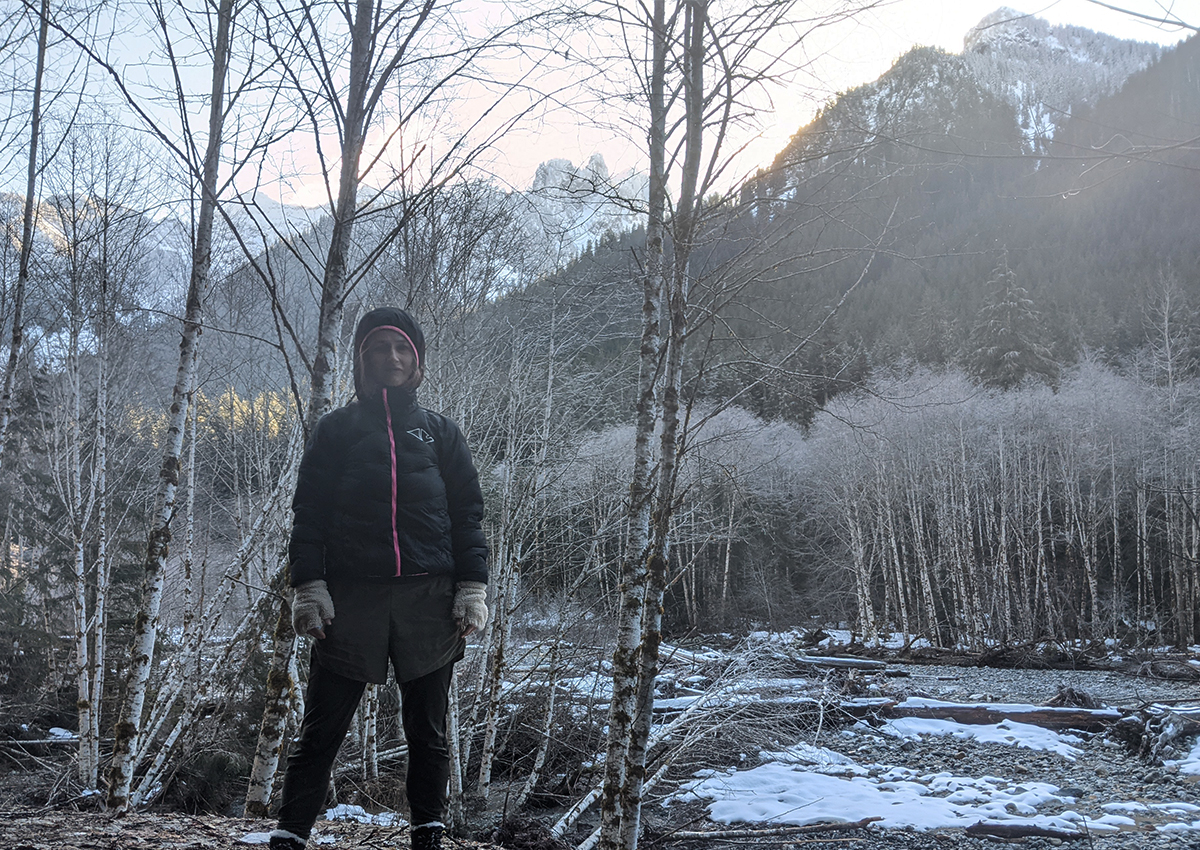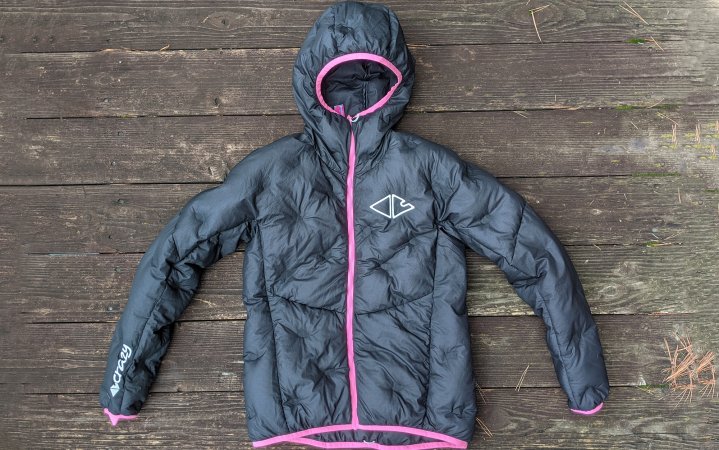We may earn revenue from the products available on this page and participate in affiliate programs. Learn More ›
Claiming the mantle of “lightest weight” is a pretty big deal for outdoor gear. Titanium pots, carbon fiber tent poles, Dyneema backpacks; each category has its material du jour. For puffer jackets, manufacturers are seemingly in a goose down arms race: 700 fill power, 800 fill power, 900 fill power—and then, most recently, 1,000 fill power. So when the Crazy Levity came across my rader, claiming to have 1,000 fill power and a 6.1-ounce weight, while still being warm enough for winter activities, I had to check it out.
Crazy Levity Specs and Features
Crazy Levity
- Claimed Weight: 6.1 ounces (men’s); 5.4 ounces (women’s)
- Fill Power: 950 to 1000 fill power
- Fill Weight: 2.9 ounces (men’s), 2.4 ounces (women’s)
- Shell: 7D nylon
- One zip pocket at left chest (men’s); one zip pocket at inside right waist (women’s)
- Hooded
- Downpass certified
The Crazy Levity jacket is an exceptionally lightweight puffer jacket. It has 950 to 1,000 fill power down—the highest I’ve seen advertised for a puffer jacket. To understand why that’s significant, let’s take a look first at what “fill power” means. Down, whether it’s duck or goose, works by trapping hot air inside the wispy filaments attached to the feather’s shaft. But not all down is created equal. Some have long filaments that can trap more hot air, known as “loft,” than others. To measure down’s loft, 30 grams of down is placed in a cylindrical tube. Higher loft down will fill a greater volume: 600 cubic inches versus 900 cubic inches, say. So 30 grams of 1,000 fill power would fill 1,000 cubic inches.
Read Next: The Best Puffer Jackets of 2023

It’s fairly common with outdoor manufacturers to advertise the fill power of a particular jacket or sleeping bag. But that’s only half the story. Even if a puffer jacket is boasting a high fill power, if it doesn’t have very much of it, it’s sacrificing warmth. The Crazy Levity has 2.9 ounces of fill (2.4 ounces for the women’s), almost half of the jacket’s claimed total weight. Here’s how it stacks up against other 1,000-fill power hooded puffer jackets.
| 1,000fp Puffer Jackets | Weight (ounces) | Fill Weight (ounces) | Percent of Down in the Total Weight |
| Crazy Levity | 6.1 | 2.9 | 47.5 |
| Mountain Hardwear Ghost Whisperer UL | 6.7 | 2 | 29.9 |
| Rab Zero G | 11 | 4.5 | 40.1 |
| Montbell Plasma 1000 Alpine | 8.4 | 3.4 | 40.1 |
| Eddie Bauer Centennial Collection MicroTherm 1000 | 9.6 | 3.2 | 33.3 |
Next, Levity cut almost all non-essential features: No zip pockets at the waist, no cinch cords at the hem or hood, and the barest trace of elastic at the cuffs and the hem. This allowed Levity to cut even more weight out of this jacket without affecting its ability to keep you warm. This got them down to a claimed 6.1 ounces for a men’s medium and 5.4 ounces for a women’s medium.

Finally, the Crazy Levity jacket took an usual approach to baffling. The reason baffling is important in puffer jackets is that, without it, the down can start to redistribute and sink downward, resulting in cold spots. The vast majority of puffer jackets sew the baffling in, typically in horizontal lines. But the Crazy Levity eschews thread, opting instead to glue in small horizontal ovals at regular intervals. The idea here is to save a little bit of weight by eliminating the need for thread, and also to prevent down from poking out through the seams of the jacket—a common way that down coats lose feathers, especially when they are new.
Testing the Crazy Levity in the Field
I wore the Crazy Levity in a number of different scenarios, from sleet to ice to snow to rain, while hiking, skiing, and just sitting around. Typically, I paired it with nothing more than a simple base layer (sometimes just a T-shirt) and, if necessary, a lightweight rain shell. After having been burned by a number of so-called lightweight (really mid-layer) puffer jackets, I wanted to make sure the Crazy Levity actually did what puffer jackets are supposed to do: Keep you warm in cold weather.

Verdict: Yes. While I’m not going to recommend this puffer jacket for Alaskan winters, in my experience it was warmer than other standard puffer jackets like the REI Magma Hoodie or the Mountain Hardwear Ghost Whisperer II—while still weighing the same or less than other ultra lightweight puffer jackets. Perhaps most surprisingly, the down has yet to redistribute; those sparse glued-in ovals actually work.
I’m used to super lightweight clothing having a tight fit, so I was glad to see that this wasn’t the case here. I’m five foot five, with an unusually long torso, and tried out a woman’s small. The hem easily pulled down to mid hip. The sleeves had an extra inch at the end of them. Even the cowl and hood were generously sized—I could have easily fit a second whole puffer jacket underneath the Crazy Levity.

So, is the Crazy Levity actually the lightest weight hooded puffer jacket on the market? After using this jacket for several months, I finally got around to weighing it. The women’s medium that I had came in at 6.1 ounces—over half an ounce heavier than claimed. On the off chance that some errant water weight was contributing to this (moisture gets in everything in the PNW eventually), I stuck the jacket inside a small room with a heavy-duty dehumidifier for several hours. When I took it back out again, it still weighed 6.1 ounces. While there is always going to be some variability in the weight at the margins of products like this, .7 ounces (or 20 grams) is more than I would have expected.

In my experience, a 7 denier shell may also be a hair too thin for a jacket stuffed to the brim with down. Even if you are extremely careful, and never brush the wrong bush or rock, the end of the down’s shaft can poke through the material. If you see this happening with your puffer jacket, it’s best to resist the urge to pull on it, as the material will start to tear even more as the feather (and inevitably three more after it) pulls through.

I did appreciate that Levity anticipated that users might need to patch the shell and provided a simple sheet that can be cut to size and ironed on. But whether or not you think the trade-off of weight for durability in this instance is worth it is likely subjective.
What the Crazy Levity Does Best
The Crazy Levity answers the question, “How lightweight can a puffer jacket get and still actually keep you warm?” This jacket is ounces lighter than other best-in-class puffer jackets and still turns out to be warmer than the likes of the 8.8-ounce Mountain Hardwear Ghost Whisperer and 7.3-ounce Norrona Trollvegen. And it does that without sacrificing coverage. If you’ve been hesitant to go all-in on one of Montbell’s UL options due to coverage concerns, you won’t have that issue here.
What the Crazy Levity Does Worst
At $650, this is an exceptionally expensive jacket—hundreds of dollars more than its competitors. Its durability issues over the course of a single season of testing were also significant enough that it’s unlikely this will be the last puffer jacket you ever own. While some may decry the lack of pockets or cinch cords, my feeling is that Levity took the process of cutting back on the “features” to the very edge, but didn’t step over the line.
Final Thoughts
The bottom line here is that if weight is your only consideration (and I know you are out there), then the Crazy Levity is truly a must-have. Until someone figures out how to secure and measure 1,100 fill power down or creates a robust 2 denier shell fabric, the Crazy Levity is likely to rule the roost as the lightest winter-ready insulation layer available.

